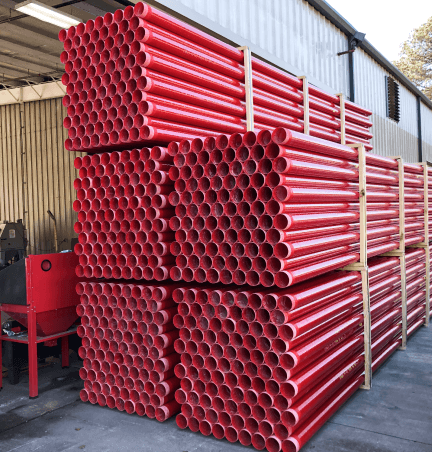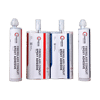Applications and Usage
The main difference is in fire resistance. Above ground conduit has fire resistance per UL2515 and CSA C22.2 No. 2515 standards, meaning that the conduit will self-extinguish within 15 seconds after each of five successive flame applications per the UL 2515 flame test standard.
Below ground conduit meets UL94 HB (horizontal burn) requirements, which aren’t as stringent as vertical burn requirements. This also means that conduit manufactured and labeled for “above ground” applications can be used for “below ground” applications.
For special applications, XWall conduit with a thickness of .25″ can be used. Many of the telephone companies use this type of conduit for protection of fiber optic cables in above ground installations. XWall conduit has been shown to stop a .22 caliber bullet.
Use the Champion Fiberglass Conduit Calculator to estimate possible savings when using Champion Haz Duct® XWall Type Conduit vs. other in-market conduit materials.
For examples of which products have been used in tough environments similar to yours, visit our Case Studies section. You’re also welcome to contact us – we’ll do our best to connect you to the right answer in a timely manner.
Base the diameter of conduit on the allowable wire fill per page 56-57 in this catalog. For support distance, see pages 58-61; view information on updated support span distances here. Normally, a mid-span deflection 5/8″ or 16mm should not be exceeded.
Use the Champion Fiberglass Conduit Calculator to estimate possible savings when using Champion Fiberglass Conduit vs. other in-market conduit materials.
Visit our Industry pages – you’ll see ample data backing up Champion Fiberglass’s success in and support for industries including wastewater treatment, port authority, data center applications, petrochemical, tunnels, transportation, utilities, pipeline, and industrial/commercial.
Please refer to the deflection charts on pages 58 – 61 in the Engineering section of this catalog. After determining the weight of the cable and maximum allowable deflection (typically not exceeding 5/8″ or 16mm), use the deflection charts for selection of conduit type and support distance. See updated support spacing distances for Champion Fiberglass conduit (RTRC) here.
Use the Champion Fiberglass Conduit Calculator to estimate possible savings when using Champion Fiberglass Conduit vs. other in-market conduit materials.
Champion Fiberglass offers many opportunities to save, from a lower starting material cost to lower manpower and installation costs. Visit our comparison chart to weigh the benefits, or visit our blog to learn more about how our newly extended support spacing distances help build savings.
You can also view our updated UL Listed support spacing distances in comparison to PVC-coated steel and GRC, and make a direct material and installation comparison using our Conduit Calculator.
If you’d like to discuss actual numbers, please contact us – we’d be happy to review any project spec or details and demonstrate your opportunities to save with Champion Fiberglass.
Because of the possibility of high pressure caused by concrete, Heavy Wall conduit should be used for 4″ – 6″ diameter conduit. It is very important that the contractor/installer observes proper procedures when pumping the concrete into the core. If excessive pressure is applied, even Heavy Wall conduit may fail. Please contact Champion Fiberglass with questions on any of the above situations.
Once you’ve determined the correct conduit to use in your application, use the Champion Fiberglass Conduit Calculator to estimate possible savings when using Champion Fiberglass Conduit vs. other in-market conduit materials.
Encased in concrete (EB quality) applications can utilize Standard Wall product in most cases. Due to its high temperature rating, fiberglass conduit holds up very well for concrete encasement. (This application does not include core boring.) If UL listed material is required, use standard wall for 3/4″ – 4″ diameter, and Medium Wall for 5″ and 6″ (UL designates Champion Fiberglass MW for 5″ and 6″ as SW).
To compare possible material and installation costs for Champion Fiberglass conduit vs. other in-market materials, use the Champion Fiberglass Conduit Calculator.
Direct Buried (or DB quality) applications should utilize UL Listed conduit. Use Standard Wall for 3/4″ – 4″ diameter, and Medium Wall for 5″ and 6″ (UL designates Champion Fiberglass MW for 5″ and 6″ as SW). For very deep trenches, special soil conditions or where high rate of compacting can be expected, an even heavier wall should be selected. Please contact Champion Fiberglass with questions on any of the above situations.
To compare possible material and installation costs for Champion Fiberglass conduit vs. other in-market materials, use the Champion Fiberglass Conduit Calculator.
Fiberglass conduit enhances project safety across many industries from transportation to utilities to chemical plants and more.
For example, the transportation industry relies on Champion Fiberglass phenolic conduit for enhanced life safety electrical circuit integrity in tunnels. Champion Fiberglass XW Phenolic conduit along with RSCC Vitalink 300 RHW and Radix Duralife II Fire Alarm cables have achieved a two-hour fire rating (conduit that has been tested and can withstand fire at 1850 degrees Fahrenheit for two hours).
For utilities, the non-conductive, fault resistant properties of fiberglass conduit protect by reducing electrical fault hazards and speed up cable replacement while limiting surrounding infrastructure damage and replacement.
Fiberglass conduit is also a safe solution in extreme conditions, such as chemical plants. Unlike PVC materials, fiberglass conduit does not release toxic halogens when burning. Halogens chlorine and bromine are harmful to employees, the public, and emergency personnel alike. Champion Haz Duct® XW Type Fiberglass Conduit, which is Class I, Div 2-rated conduit system, is suitable in these harsh environments.
Fiberglass conduit promotes safety in installation due to its light weight and ease of portability. Lightweight fiberglass conduit and elbows help minimize the risk of injury to crews, while also protecting contractors from loss of productivity and downtime claims due to back strain injuries. Whether installation occurs high off the ground or over water, Champion Fiberglass conduit keeps installations running smoothly and safely because of its light weight, fault resistance, low/zero smoke, zero halogen properties.
Fiberglass elbows are frequently provided with PVC couplings to transition to underground PVC conduits. Also, PVC or fiberglass male/female adapters are used to transition to GRC and PVC-coated rigid steel conduits. We only recommend using fiberglass couplings for fiberglass-to-fiberglass connections.












